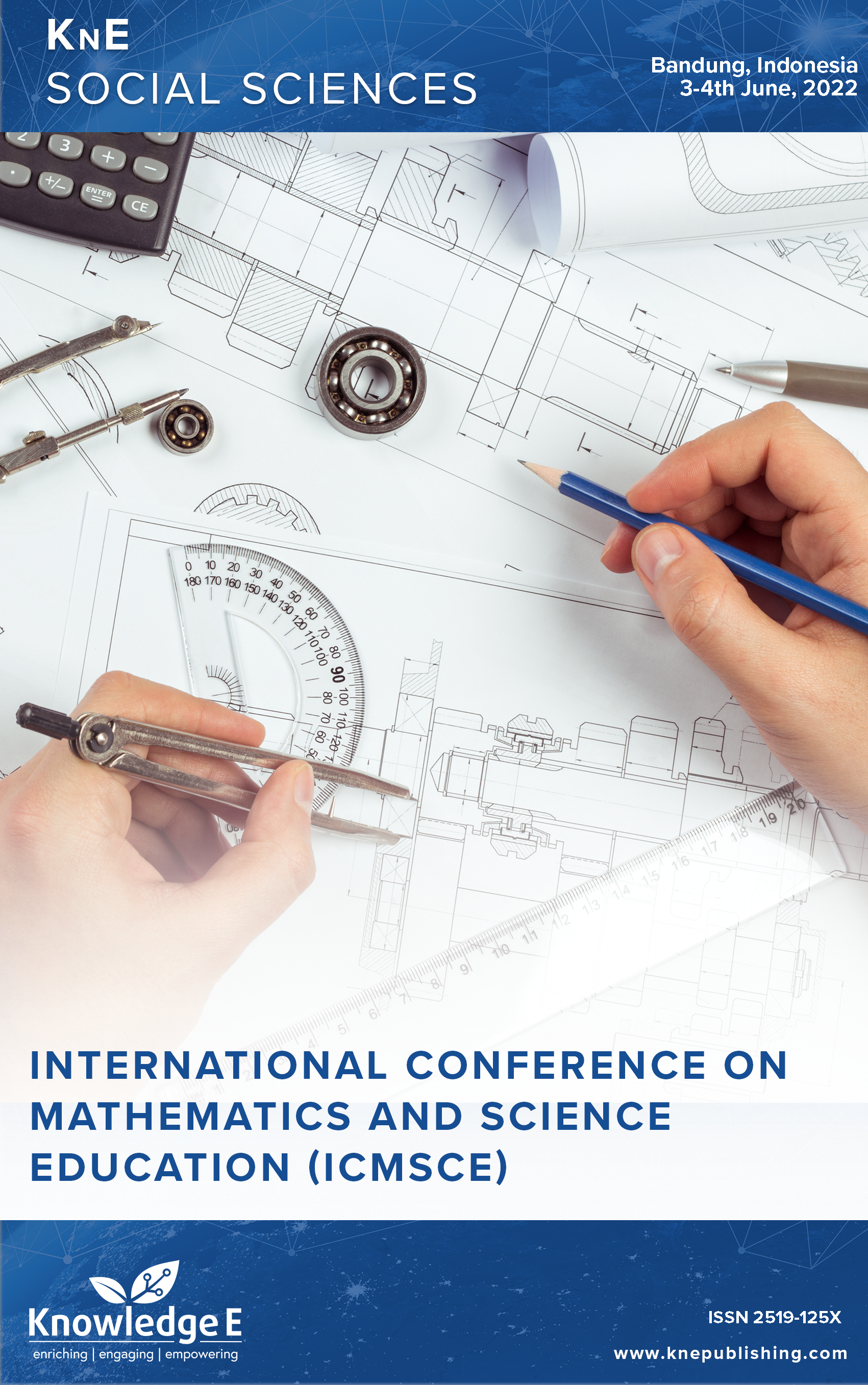Edmodo-based Blended Learning to Improving Mathematical Communication Skills and Self-regulated Learning of High School Students
DOI:
https://doi.org/10.18502/kss.v9i13.15938Abstract
This study aims to assess the improvement of mathematical communication skills and self-regulated learning in students who engage in Edmodo-based blended learning models. This research employed a quasi-experimental method. The study involved students from the first grade of high school, comprising 32 students from class MIPA 7 and 32 students from class MIPA 8. The instruments used included a test and a questionnaire. The data analysis utilized the t-test through SPSS 25.0 for Windows, specifically the Independent Sample T-test. The results indicated that 1) overall, Edmodo-based blended learning models is effective in improving students mathematical communication skills and self-regulated learning; 2) In the KAM category (high), Edmodo-based blended learning models are effective in improving students self-regulated learning; 3) The effectiveness of Edmodo-based blended learning models for students’ mathematical communication abilities is classified into medium categories. Edmodo-based blended learning has implications for teacher activeness by using technology in education and promotes student self-reliance in the learning process.
Keywords: blended learning, emodo, mathematical communication skills, self-regulated learning
References
Allen CE, Froustet ME, LeBlanc JF, Payne JN, Priest A, Reed JF, et al. National council of teachers of mathematics. Arith Teach. 2020;29(5):59. DOI: https://doi.org/10.5951/AT.29.5.0059
Nofrianto A, Maryuni N, Amri MA. Komunikasi matematis siswa: pengaruh pendekatan matematika realistik. Jurnal Gantang. 2017;2(2):113–21. DOI: https://doi.org/10.31629/jg.v2i2.199
Lomibao LS, Luna CA, Namoco RA. The Influence of mathematical communication on students’ mathematics performance and anxiety. Am J Educ Res. 2016;4(5):378–82.
Chung Y, Yoo J, Kim SW, Lee H, Zeidler DL. Enhancing students’ communication skills in the science classroom through socioscientific issues. Int J Sci Math Educ. 2016;14(1):1–27. DOI: https://doi.org/10.1007/s10763-014-9557-6
Baroody AJ. Problem Solving, Reasoning, and Communicating, K-8 Helping Children Think Mathematically. New York: Macmillan Publishing Company; 1993.
O.E.C.D. PISA 2015 Results in Focus. Columbia University, New York.
H. Hendriana, “Pembelajaran dengan pendekatan metaphorical thinking untuk meningkatkan kemampuan pemahaman matematik, komunikasi matematik dan kepercayaan diri siswa sekolah menengah pertama,” (2009).
Achir YS, Usodo B, Setiawan R. Analisis kemampuan komunikasi matematis siswa dalam pemecahan masalah matematika pada materi Sistem Persamaan Linear Dua Variabel (SPLDV) ditinjau dari gaya kognitif. Jurnal Penelitian Pendidikan. 2017;20(1):78–87. DOI: https://doi.org/10.20961/paedagogia.v20i1.16600
Nú nez JC. “Intellectual abilities, thinking styles and academic achievement.,” Eds. Psicothema. 2008;:45–66.
Q. Ainiyah, H. Suyitno, E.R. Winarti, and Prisma, “Analisis kemampuan berpikir kritis matematis pada pembelajaran pspbl berbantuan smart point ditinjau dari kemandirian belajar.,” In: PRISMA: Prosiding Seminar Nasional Matematika. pp. 279–288 (2018).
Ansori Y, Herdiman I. Pengaruh kemandirian belajar terhadap kemampuan pemecahan masalah matematis siswa SMP. Journal of Medives : Journal of Mathematics Education IKIP Veteran Semarang. 2019;3(1):11–9. DOI: https://doi.org/10.31331/medivesveteran.v3i1.646
Damanik DP, Bukit N. Analyze critical thinking skills and scientific attitude in physics learning used inquiry training and direct instruction learning model. Jurnal Pendidikan Fisika. 2013;2(1):16–24. DOI: https://doi.org/10.22611/jpf.v2i1.4333
Aini DF. Pengembangan pedoman e-modul berorientasi student active learning sebagai pendukung pembelajaran di Sekolah Dasar. Jurnal Pendidikan Dasar Nusantara. 2020;5(2):292–304. DOI: https://doi.org/10.29407/jpdn.v5i2.13999
Garrison DR, Vaughan ND. Blended Learning in Higher Education: Framework, Principles, and Guidelines. San Francisco (CA): John Wiley & Sons; 2008. DOI: https://doi.org/10.1002/9781118269558
Martin JS, Kreiger JE, Apicerno AL. Effectiveness of a hybrid classroom in the delivery of medical terminology course content relative to a traditional classroom format. J Scholarsh Teach Learn. 2015;15(5):72–81. DOI: https://doi.org/10.14434/josotl.v15i5.13994
Harahap F, Nasution NE, Manurung B. The effect of blended learning on student’s learning achievement and science process skills in plant tissue culture course. Int J Instr. 2019;12(1):521–38. DOI: https://doi.org/10.29333/iji.2019.12134a
Firdaus S, Isnaeni W. Motivation and learning achievement of primary students in theme-based learning using blended learning model. Journal of Primary Education. 2018;7(3):324–31.
M.J. Kintu, C. Zhu, and E. Kagambe, “Blended learning effectiveness: The relationship between student characteristics, design features and outcomes.,” International Journal of Educational Technology in Higher Education. vol. 14, no. 1, p. 2017. https://doi.org/10.1186/s41239-017-0043-4. DOI: https://doi.org/10.1186/s41239-017-0043-4
Ceylan VK, Elitok Kesici A. Effect of blended learning to academic achievement. Int J Hum Sci. 2017;14(1):308. DOI: https://doi.org/10.14687/jhs.v14i1.4141
Dewi WA. Dampak COVID-19 terhadap implementasi pembelajaran daring di sekolah dasar. Edukatif : Jurnal Ilmu Pendidikan. 2020;2(1):55–61. DOI: https://doi.org/10.31004/edukatif.v2i1.89
Gredler ME. “Learning and instruction: Teori dan aplikasi, terjemahan Tri Wibowo.,” Jakarta: Kencana Prenada Media. p. 2011.
Sugiyono, Metode penelitian pendidikan: Pendekatan kuantitatif, kualitatif dan R&D. Alfabeta, Bandung, 2013.
Bibi S, Jati H. Efektivitas model blended learning terhadap motivasi dan tingkat pemahaman mahasiswa mata kuliah algoritma dan pemrograman. Jurnal Pendidikan Vokasi. 2015;5(1):74. DOI: https://doi.org/10.21831/jpv.v5i1.6074
Rizqi AA. Kemampuan komunikasi matematis siswa melalui blended learning berbasis pemecahan masalah. PRISMA, Prosiding Seminar Nasional Matematika. 2016;1(1):191–202.
S. Nurjanah, “Peningkatan kemampuan pemahaman relasional dan pemecahan masalah matematis serta self regulated learning siswa SMA melalui pembelajaran secara daring (Edmodo dan Google Classroom),” (2020).
Purnamasari A, Afriansyah EA. Kemampuan komunikasi matematis siswa smp pada topik penyajian data di pondok pesantren. Jurnal Pendidikan Matematika. 2021;1(2):207–22. DOI: https://doi.org/10.31980/plusminus.v1i2.896
Zulfitria A, Fadhillah R. “Penggunaan Teknologi dan Internet sebagai Media Pembelajaran di Masa Pandemi Covid-19.,” In: Prosiding Seminar Nasional Penelitian LPPM UMJ (2020).
Ningsih YL, Misdalina M, Marhamah M. Peningkatan hasil belajar dan kemandirian belajar metode statistika melalui pembelajaran blended learning. Al-Jabar : Jurnal Pendidikan Matematika. 2017;8(2):155. DOI: https://doi.org/10.24042/ajpm.v8i2.1633
Kurnia D, Warmi A. Analisis Self-Regulated Learning dalam Pembelajaran Matematika pada Siswa SMP Kelas VIII Ditinjau dari Fase-fase Self-Regulated Learning. Karawang; 2020.
H.L. Tasaik and P. Tuasikal, “Metodik Didaktik.,” Jurnal Pendidikan Ke-SD-an. vol. 14, p.
Hamka D, Effendi N. Pengembangan media pembelajaran blended learning berbasis Edmodo pada mata kuliah fisika dasar di program studi pendidikan IPA. Journal of Natural Science and Integration. 2019;2(1):19. DOI: https://doi.org/10.24014/jnsi.v2i1.7111
Hardhono A. Potensi teknologi komunikasi dan informasi dalam mendukung penyelenggaraan pendidikan jarak jauh di indonesia. Jurnal Potensi ICT PJJ Indonesia. 2012;1:1–11.

